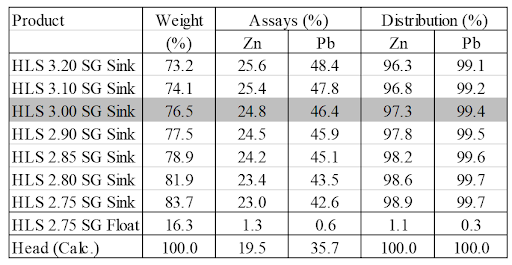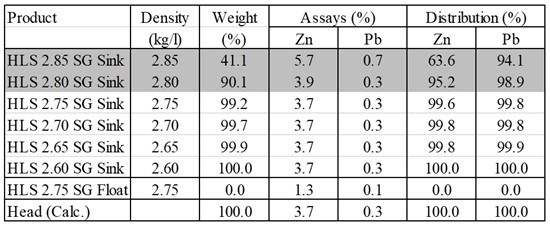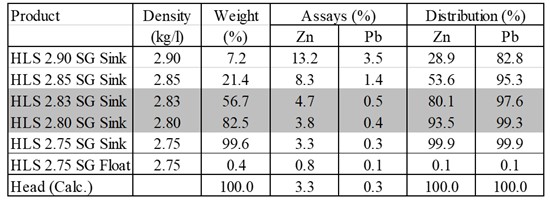EDM Announces Positive Results of the Dense Media Separation Study
EDM reports DMS pilot tests at Scotia Mine show improved grades, high recoveries, reduced costs, and potential for increased zinc and lead production, boosting project economics.

Michael Chen
Senior Mining Analyst
Halifax, Nova Scotia--(Newsfile Corp. - August 11, 2025) - EDM Resources Inc. (TSXV: EDM) (FSE: P3Z) ("EDM" or the "Company") is pleased to announce the final results of the Dense Media Separation Study on all zinc and lead composite samples from its Scotia Mine. The final tests indicate that it may be possible to pre-concentrate crushed run-of-mine material using Dense Media Separation ("DMS") prior to flotation, thereby potentially reducing the overall cost of mineral processing at the Scotia Mine.
Highlights of the DMS pilot plant operation
- Increase in grades by 18.4% for zinc and 33.5% for lead.
- Recoveries of 88.4% of zinc and 99.7% of lead.
- Potential reduction to processing costs per pound of zinc produced due to increase in processing head grade.
- Reduction in waste mineral processing of up to 25%.
- Expected to have an overall positive impact on the project economics.
"EDM is very excited by the results of the final HLS and DMS pilot plant test work, which indicated an 18% overall increase in zinc feed grades and a 34% increase in lead feed grades. Applied conceptually to the 2021 PFS processing schedule, a full-scale DMS plant could increase the total amount of zinc and lead concentrate produced at the Scotia Mine as typically a DMS pilot plant's results are indicative of a full scale DMS process." said, Mr. Mark Haywood, President & CEO. "In addition, more efficient processing of the Scotia Mine ores would potentially enable more ore to be processed in the flotation and dewatering circuits, thereby decreasing the overall processing costs per tonne which could increase the overall NPV of the project," he added.
HLS Testwork Details
A Dense Media Separation plant utilizes a gravity separation process that relies on the differences in density between mineralized rock and non-mineralized rock, and uses a non-toxic slurry of heavy media and water to effect a separation. HLS testing is a bench-scale process that is used to simulate the full-scale DMS process. It utilizes a bath of organic heavy liquid at various densities to incrementally split out the heavier mineralization (which sinks in the liquid) and the lighter waste (which floats to the top of the liquid).
On an industrial scale, a DMS plant at the Scotia Mine would be designed to process a crushed run of mine stream, and to significantly reduce the amount of sub-economic (waste) material that would otherwise be processed through the Scotia Mine's mill. As a relatively simple, environmentally friendly and cost-efficient metallurgical process, a DMS plant can significantly reduce the overall processing costs at the Scotia Mine which would also allow a lowering of cut-off grade and access to otherwise uneconomic areas of the deposit.
The HLS tests were performed on material from two 10-kilogram samples that were collected from the high-grade mineralized zones of the Scotia Mine. One sample was 100% crushed to 12.7mm (1/2") in preparation for "Test T1". On completion of Test T1, the second sample was then crushed to 6.3mm (1/4") for "Test T2". The minus 0.85mm size fraction was removed from both samples prior to HLS testing.
Additional HLS tests were also performed on material from two 10-kilogram samples that were collected from the blended-grade mineralized zones of the Scotia Mine. A first sample was 100% crushed to 6.3mm (1/4") in preparation for "Test T3". On completion of Test T3, the second sample was then crushed to 3.3mm for "Test T4". The minus 0.85mm size fraction was removed from both samples prior to HLS testing. The head grades of the high-grade sample are shown as follows in Table 1, with the results of all HLS Tests shown in Tables 2, 3, 4 and 5 below:
Table 1 - Sample Head Grades

To view an enhanced version of this graphic, please visit:
https://images.newsfilecorp.com/files/6904/261977_edm_table1.png
Table 2: HLS Test T1 Results

To view an enhanced version of this graphic, please visit:
https://images.newsfilecorp.com/files/6904/261977_edm_table2.png
Table 3: HLS Test T2 Results

To view an enhanced version of this graphic, please visit:
https://images.newsfilecorp.com/files/6904/261977_edm_table3_550.jpg
Table 4: HLS Test T3 Results

To view an enhanced version of this graphic, please visit:
https://images.newsfilecorp.com/files/6904/261977_edm_table4_550.jpg
Table 5: HLS Test T4 Results

To view an enhanced version of this graphic, please visit:
https://images.newsfilecorp.com/files/6904/261977_edm_table5_550.jpg
SGS selected optimal SGs for HLS recoveries of zinc and lead, as well as the mass recovered.
For HLS Test T1: At an optimal SG of 3.00, 76.5% of mass was retained, along with 97.3% of zinc and 99.4% of lead
For HLS Test T2: At an optimal SG of 3.00, 80.2% of mass was retained, along with 97.6% of zinc and 99.4% of lead
For HLS Test T3: At an optimal SG of 2.80, 90.1% of mass was retained, along with 95.2% of zinc and 98.9% of lead
For HLS Test T4: At an optimal SG of 2.80, 82.5% of mass was retained, along with 93.5% of zinc and 99.3% of lead
DMS Details and Results
The DMS feed from the blended-grade samples was stage-crushed to 100% passing 3.3 mm and split into two equal charges, after removal of minus 0.85 mm fines. The first DMS operation (PP-04) was carried out at a SG cut-point of 2.83. The second DMS operation (PP-05) was then carried out at a lower SG cut-point of 2.81 with the second DMS charge as feed. The third DMS operation (PP-06) was carried out at a lower SG cut-point of 2.77 with PP-05 floats as the feed.
The combined sinks from PP-05 and PP-06 attained the target mass split. The combined PP-05 and PP-06 operation simulated one DMS operation at a SG cut-point of 2.77.
Table 6: Overall Stage Balance for DMS Plant Operations at SG 2.77 (including Fines)

To view an enhanced version of this graphic, please visit:
https://images.newsfilecorp.com/files/6904/261977_edm_table6_550.jpg
Based on the results of the HLS tests and DMS operations, the following conclusions were summarized:
- Based on the HLS test results at two crush sizes of 6.4 mm and 3.3 mm, 3.3 mm was selected as the crush size of DMS operation.
- Three DMS pilot plant operations were required to achieve the target mass recovery to the sinks. The optimal SG cut point was found to be 2.77.
- The DMS stage mass recovery to the sinks was 57.8%. The stage lead and zinc recoveries were 99.0% and 73.9%, respectively. The lead and zinc grades were 0.37% Pb and 3.98% Zn, respectively.
- The mass recovery to the flotation feed (sinks + fines) was 74.7%. The lead and zinc recoveries were 99.7% and 88.4%, respectively. The grades obtained were 0.58% Pb and 4.96% Zn. This represented increases of 33.5% and 18.4% in the respective grades over the calculated head grades. Overall, the results obtained from the DMS operation were comparable to the HLS tests.
About Dense Media Separation (DMS)
DMS is a relatively simple and inexpensive method of pre-concentrating mineralization before it enters the Grinding and Flotation Circuits at the Scotia Mine. It has been used extensively worldwide on many types of minerals, including projects similar to the Scotia Mine. After crushing, the material is processed through cyclones typically using a ferro-silicon media that will allow non-mineralized rock to "float" and be collected as waste, while mineralized material will "sink" and be directed to the grinding circuit as higher graded mill feed. EDM already has a 2,700 tonnes per day mill concentrator on site at the Scotia Mine, so a DMS plant could be added prior to the Flotation Circuit in the existing processing building.
Mr. Curtis Mohns, P.Eng., Senior Metallurgist for SGS Canada Inc. and a Qualified Person as defined under NI43-101, has approved the technical information contained in this news release related to the HLS and DMS test work.
Other Corporate Matters
A total of 2,800,000 stock options have been granted to certain directors, officers, employees and consultants at a strike price of C$0.09. All options expire on August 8, 2030, and are subject to the Company's Stock Option Plan and the policies of the TSX Venture Exchange ("TSX.V").
About EDM Resources Inc.
EDM is a Canadian exploration and mining company that has full ownership of the Scotia Mine and related facilities near Halifax, Nova Scotia. Through its wholly owned subsidiary, EDM also holds several prospective exploration licenses near its Scotia Mine and in the surrounding regions of Nova Scotia.
The Company's common shares are traded on the TSX Venture Exchange under the symbol "EDM" and the Frankfurt Exchange under the symbol "P3Z". For more information, please contact:
Mark Haywood
President & Chief Executive Officer
Arnab De
Chief Financial Officer
Manish Grigo
Corporate Development
Telephone +1 (902) 482 4481
Facsimile +1 (902) 422 2388
Email & Web [email protected] & www.EDMresources.com
The Company's corporate filings and technical reports can be viewed on the Company's SEDARPLUS profile at www.sedarplus.ca. Further information on EDM is also available on Facebook at http://www.facebook.com/EDMresources.inc, Twitter at http://www.twitter.com/EDMresources, LinkedIn at http://www.linkedin.com/company/EDMresources and YouTube at https://youtube.com/@edmresources?si=Bvyighil3mSoOKnD
CAUTIONARY STATEMENTS
Neither the TSX Venture Exchange nor its Regulation Services Provider(as that term is defined in the policies of the TSX Venture Exchange) accepts responsibility for the adequacy or accuracy of this news release.
This news release includes certain forward-looking statements which are not comprised of historical facts. Forward-looking statements include estimates and statements that describe the Company's future plans, objectives or goals, including words to the effect that the Company or management expects a stated condition or result to occur. Forward-looking statements may be identified by such terms as "believes", "anticipates", "expects", "estimates", "may", "should", "could", "would", "will", or "plan". Since forward-looking statements are based on assumptions and address future events and conditions, by their very nature they involve inherent risks and uncertainties. Although these statements are based on information currently available to the Company, the Company provides no assurance that actual results will meet management's expectations. Risks, uncertainties, and other factors involved with forward-looking information could cause actual events, results, performance, prospects, and opportunities to differ materially from those expressed or implied by such forward- looking information. Forward-looking information in this news release includes, but is not limited to, the Company's objectives, goals or future plans, statements, potential mineralization, exploration and development results, the estimation of mineral resources, exploration and mine development plans, timing of the commencement of operations and estimates of market conditions. There can be no assurance that forward-looking statements will prove to be accurate and actual results and future events could differ materially from those anticipated in such statements. Important factors that could cause actual results to differ materially from EDM's expectations include, among others, the degree to which mineral resource and reserve estimates are reflective of actual mineral resources and reserves, the degree to which factors are present which would make a mineral deposit commercially viable, the price of zinc, lead and gypsum, uncertainties relating to availability and costs of financing needed in the future, changes in equity markets, risks related to international operations, the actual results of current exploration activities, delays in the development of projects, conclusions of economic evaluations and changes in project parameters as plans continue to be refined as well as future prices of metals, ability to predict or counteract potential impact of COVID-19 coronavirus on factors relevant to the Company's business, as well as those factors discussed in the section entitled "Risk Factors" in EDM's management's discussion and analysis of the Company's annual financial statements for the period ended December 31, 2024. Although EDM has attempted to identify important factors that could cause actual results to differ materially, there may be other factors that cause results to be not as anticipated, estimated or intended. There can be no assurance that such statements will prove to be accurate as actual results and future events could differ materially from those anticipated in such statements. Accordingly, readers should not place undue reliance on forward-looking statements.

To view the source version of this press release, please visit https://www.newsfilecorp.com/release/261977
Tags

Michael Chen
Michael has over 15 years of experience covering junior mining companies, with a focus on precious metals exploration and development.
View All Articles →